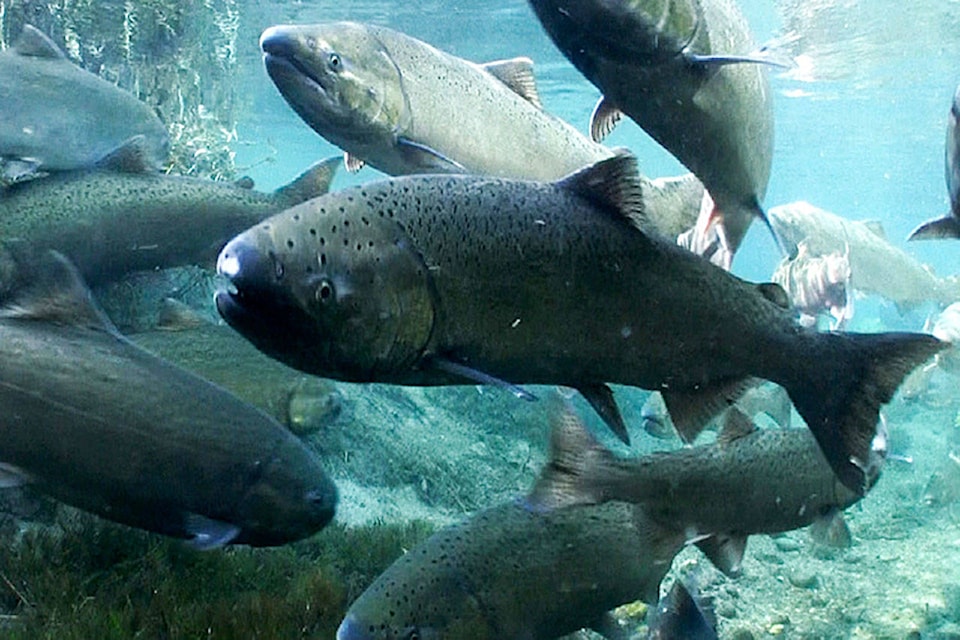More chinook salmon populations have landed on the endangered species list in B.C.
Among 28 southern groups now assessed by the Committee on the Status of Endangered Wildlife in Canada (COSEWIC), only two remain “not at risk.”
“Some of them are not in good shape at all,” said COSEWIC chair John Reynolds.
“It’s risky to predict the future with salmon, because sometimes they surprise us in a good way, but a lot of it will have to do with what people decide they want to do about it. If people want to commit the time and resources, deciding the benefits of recovering these species are greater than the cost, then their future could be different.”
Adding to 2018 assessments on 16 populations, this year COSEWIC focused on 12 southern groups whose numbers are significantly augmented by large-scale hatcheries. Counting only the wild fish, four populations are endangered — the most dire category prior to extinction in the wild— three are threatened, and one is of special concern. As in 2018, just one is not at risk. Three remote populations are data deficient.
With many salmon runs experiencing the lowest returns on record, there has been mounting public pressure for the federal government to step up hatchery production through the Salmonid Enhancement Program.
But conservation groups and scientists are sounding the alarm on the long-term consequences of high-volume hatcheries. Because the genes of fish change rapidly to suit their environment, the biggest concern is fish reared under ideal hatchery conditions will pass on inferior traits. After successive generations, the population could be unfit for the wild.
READ MORE:
“If you end up swamping a stream with hatchery genes, I don’t think that is a good recipe for long-term survival of the population, unless you’re prepared to perpetually keep putting out fish from hatcheries. That’s not what DFO’s policy is though. It’s to put wild salmon first,” Reynolds said.
He stressed small community hatcheries have a negligible impact on wild salmon and often benefit smaller depleted runs. The 23 federally-controlled hatcheries of concern release hundreds of millions of juvenile salmon per year.
COSEWIC released its conclusions in November. The detailed findings will not be available until the fall of 2021.
Until then, the actual numbers of wild versus hatchery fish in the latest assessments is unclear, but Reynolds said the competition is “significant — the proportion of hatchery fish can be quite high.”
Importance to fisheries
B.C.’s iconic chinook salmon have high cultural value to First Nations, and are also an economic driver worth hundreds of millions of dollars to both the tourism and commercial fishing industries. The human appetite for chinook is also in competition with more than 100 marine and land animals that favour the food source.
Predation, climate change, salmon farms and over-fishing are often blamed for cumulative impacts on chinook mortality.
The Pacific Salmon Foundation (PSF) is undertaking a comprehensive, first-of-its-kind analysis in B.C. on the impacts of hatcheries, and whether they’re meeting their objectives. PSF Science advisor Brian Riddell emphasized the need for limiting hatchery fish to 30 per cent of a stock, and approaching the unique needs of each wild population individually.
“You can’t have everything at once. You can’t substantially increase the numbers without having an effect on the productivity of the natural stock. But you can have a more balanced approach and gradually restore the population but you have to protect the integrity of the local genetic adaptations.”
READ MORE:
Both the recreational and commercial fishing sectors are vocal supporters of hatchery production. Sport fishing groups, who say they are unfairly targeted with angling restrictions, are also pushing for the tagging of all hatchery chinook so they can more easily target the fish and potentially enjoy more openings.
Joy Thorkelson, president of the United Fishermen And Allied Workers’ Union agreed, adding all species of hatchery fish are vital to the commercial sector.
“If there wasn’t a hatchery there wouldn’t be any fish,” she said. “As habitat has been destroyed there’s been more populations that are at risk, but they’ve been replaced by hatchery fish so we can continue to catch food. All of the major fisheries depend on hatchery fish to varying degrees.”
Government concerns
B.C.’s new parliamentary secretary for fisheries and oceans, Fin Donnelly, has been given a list of mandates to protect and conserve wild salmon populations, including the order to “support innovation in fish hatcheries”.
Aaron Hill, executive director for the Watershed Watch Salmon Society worries this will translate to a robust hatchery program that caters to the economic needs of fisheries, and not the needs of the wild fish themselves.
In a phone interview, Donnelly shared the concern of hatchery genes being passed to wild populations through federally controlled, large-scale hatcheries, but the strategic use of small hatcheries will remain an important component in provincial efforts to rebuild stocks.
“Community hatcheries and target-based hatcheries—we see it provincially as part of the solution. They play an important role, not just in what they do for salmon rearing, but in education and community engagement.”
The PSF’s scientific review of hatchery impacts will play a critical role in informing the province’s approach, Donnelly added.
The full COSEWIC study will be formally submitted to the environment ministry in the fall of 2021, at which time the Species at Risk Act listing process will begin for the assessed chinook populations.




